Chapter 3
Practice Test 1
Click here to download and print the PDF version of Practice Test 1.
PRACTICE SAT SUBJECT TEST IN LITERATURE 1
TEST 1
Your responses to the SAT Subject Test in Literature questions should be filled in on Test 1 of your answer sheet.
LITERATURE TEST 1
Directions: This test consists of selections from literary works and questions on their content, form, and style. After reading each passage or poem, choose the best answer to each question and fill in the corresponding oval on the answer sheet.
Note: Pay particular attention to questions that contain the words NOT, LEAST, or EXCEPT.
Questions 1-9. Read the following passage carefully before you choose your answers.
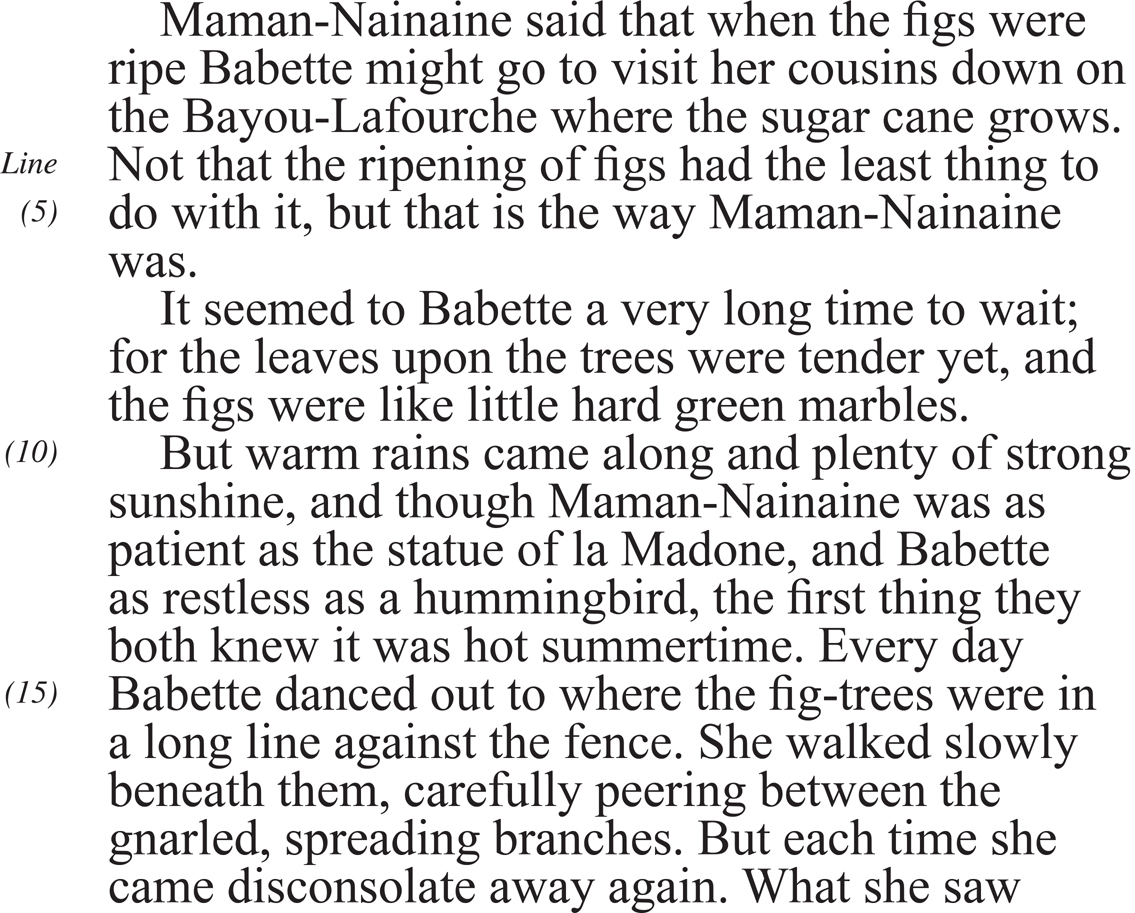
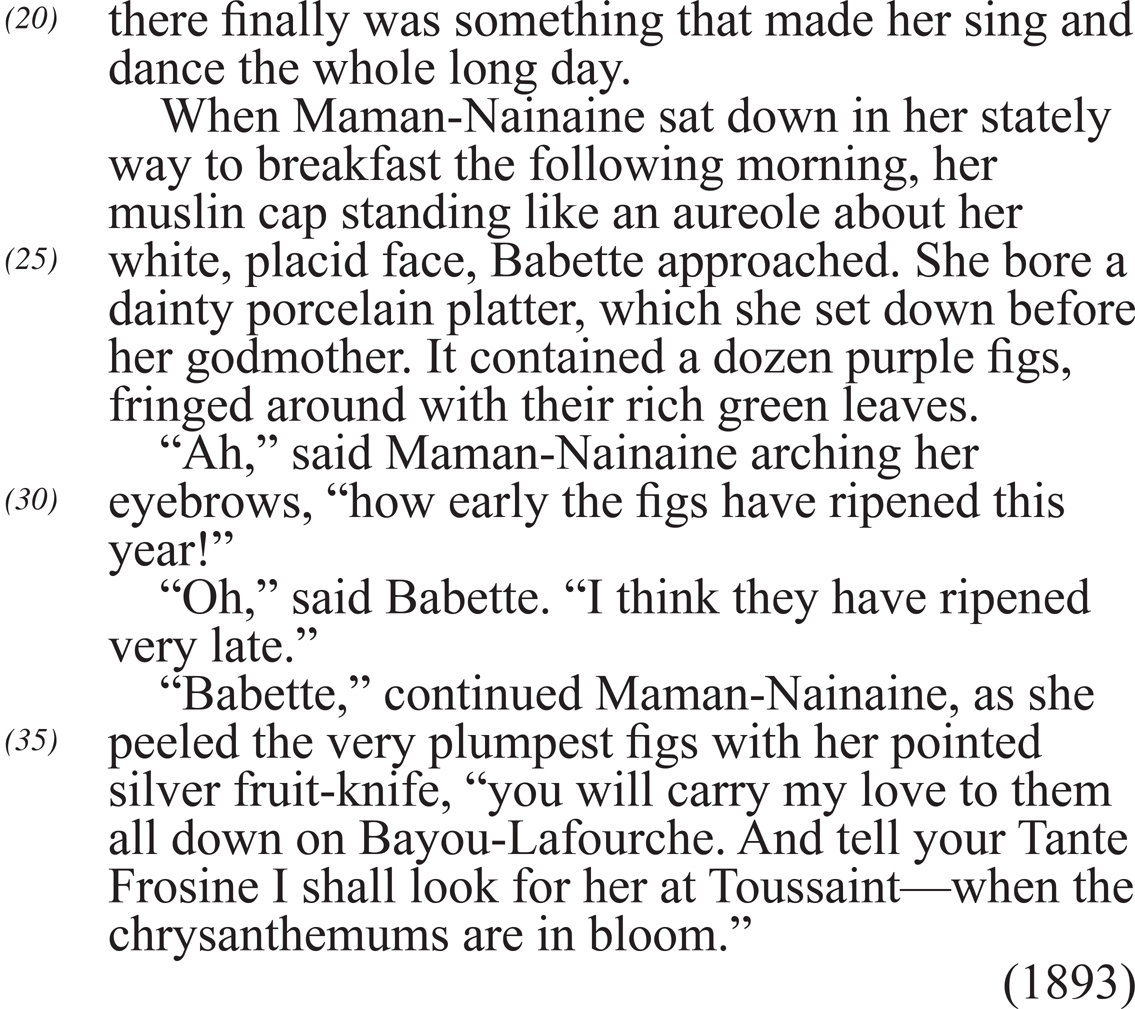
1. In the passage, the ripening figs are symbolic of
(A) the fruits of labor
(B) the maturation of Babette
(C) the difficulty of life
(D) the enigma of nature
(E) the battle between Maman-Nainaine and Babette
2. The phrase “but that is the way Maman-Nainaine was” (lines 5-6) suggests which of the following about Maman-Nainaine?
(A) She was not aware of the seriousness of the situation.
(B) She was an overly strict woman.
(C) Her actions had their own logic.
(D) She doled out punishment for no reason.
(E) Figs were her favorite fruit.
3. The phrases “patient as the statue of la Madone” (line 12), “her stately way” (lines 22-23), and “like an aureole about her white, placid face” (lines 24-25) serve to
(A) illustrate that Maman-Nainaine is completely out of touch with the present
(B) suggest that Maman-Nainaine’s patience is a positive characteristic
(C) indicate that Maman-Nainaine is as virtuous as a saint
(D) suggest that time has little significance in the world of the story
(E) make Babette seem unattractive by comparison
4. In the passage, Maman-Nainaine’s attitude toward Babette can best be characterized as
(A) contemptuous
(B) flippant
(C) reluctantly accepting
(D) joyously optimistic
(E) wisely patient
5. All of the following pairs of words illustrate the difference between Maman-Nainaine and Babette EXCEPT
(A) “patient” (line 12) and “restless” (line 13)
(B) “early” (line 30) and “late” (line 33)
(C) “purple” (line 27) and “green” (line 28)
(D) “danced” (line 15) and “sat” (line 22)
(E) “ripe” (line 2) and “bloom” (line 39)
6. Which is an effect of the last sentence of the passage?
(A) It shows that Maman-Nainaine is clearly illogical.
(B) It serves as ironic counterpoint to the rest of the story.
(C) It reinforces the suggestion that Maman-Nainaine is attuned to the rhythms of nature.
(D) It introduces a literary allusion.
(E) It advances the story beyond its scope.
7. Maman-Nainaine’s peeling of “the very plumpest figs” (line 35) illustrates that Maman-Nainaine
(A) appreciates the value of appropriate timing
(B) is gluttonous
(C) has used her knife so often it’s become misshapen
(D) is testing their ripeness
(E) has a sly and unpleasant sense of humor
8. The word “though” (line 11) implies which of the following in the context of the sentence?
(A) The two women were in disagreement.
(B) Patience is a virtue when waiting for something.
(C) Figs were not really important.
(D) Their patience and impatience had no effect on nature.
(E) Maman-Nainaine’s patience was annoying to Babette.
9. The narrative point of view of the passage as a whole is that of
(A) a disapproving observer
(B) a first-person impartial observer
(C) the protagonist
(D) an unreliable narrator
(E) a third-person objective observer
Questions 10-18. Read the following poem carefully before you choose your answers.
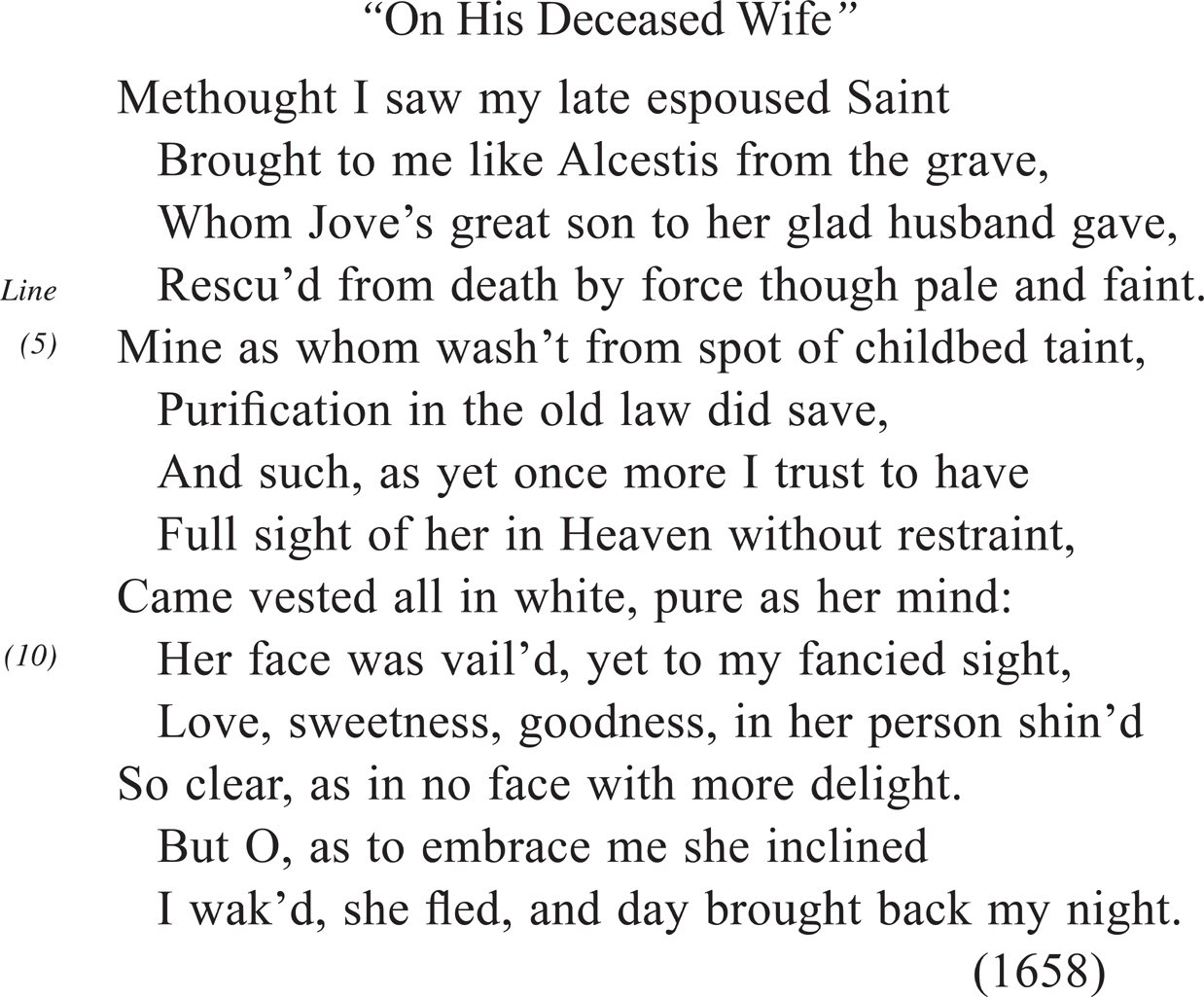
10. “Whom Jove’s great son” (line 3) acts as which of the following?
(A) A play on words
(B) A contradiction
(C) Hyperbole
(D) Mythological allusion
(E) Allegory
11. The primary effect of “as to embrace me she inclined” (line 13) is to
(A) suggest that the speaker’s wife was unsure of whether to embrace him
(B) emphasize the difference in status between the speaker and his wife
(C) make clear why the speaker was so unhappy to awaken when he did
(D) show that the speaker’s wife let her own inclinations guide her
(E) undermine the speaker’s assertions about his wife’s goodness
12. In context, the word “save” (line 6) means which of the following?
(A) Preserve
(B) Keep in health
(C) Deliver from sin and punishment
(D) Rescue from harm
(E) Maintain
13. The last line of the poem has which of the following effects?
I. Emphasizes the contrast between dreaming and waking states
II. Introduces a paradox
III. Affirms that the speaker still misses his wife
(A) I only
(B) III only
(C) I and III only
(D) II and III only
(E) I, II, and III
14. In context, “my fancied sight” (line 10) suggests that the author is
(A) imbuing his deceased wife with qualities she did not have
(B) unable to separate reality from dreams
(C) capriciously conjuring up his wife’s image
(D) dreaming
(E) suffering from delusions
15. The author’s attitude toward his wife can best be described as
(A) inconsolable
(B) reverential
(C) hopeful
(D) incongruous
(E) obsequious
16. The poem is primarily concerned with
(A) the mourning process
(B) the struggle against dying
(C) the injustice of death
(D) the nature of mortality
(E) a belief in heaven
17. What is the primary effect of “Mine as whom wash’t from spot of childbed taint” (line 5)?
(A) It explains why the speaker’s wife is wearing white.
(B) It contrasts the condition of the speaker’s wife with that of Alcestis.
(C) It suggests how the speaker’s wife had sinned.
(D) It explains why the speaker’s wife was “pale and faint” (line 4).
(E) It makes clear why the speaker’s wife needs to be purified.
18. Which of the following are terms of opposition in the poem?
(A) “embrace” and “inclined” (line 13)
(B) “day” and “night” (line 14)
(C) “Full sight” and “without restraint” (line 8)
(D) “wash’t” (line 5) and “Purification” (line 6)
(E) “sight” (line 10) and “shin’d” (line 11)
Questions 19-27. Read the following passage carefully before you choose your answers.
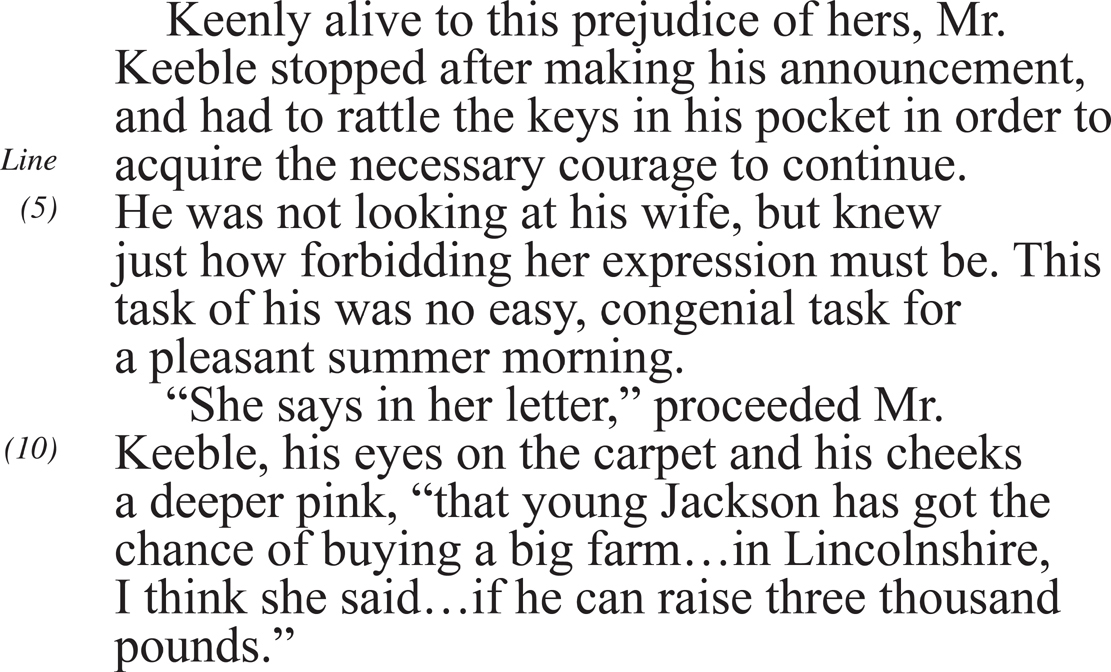
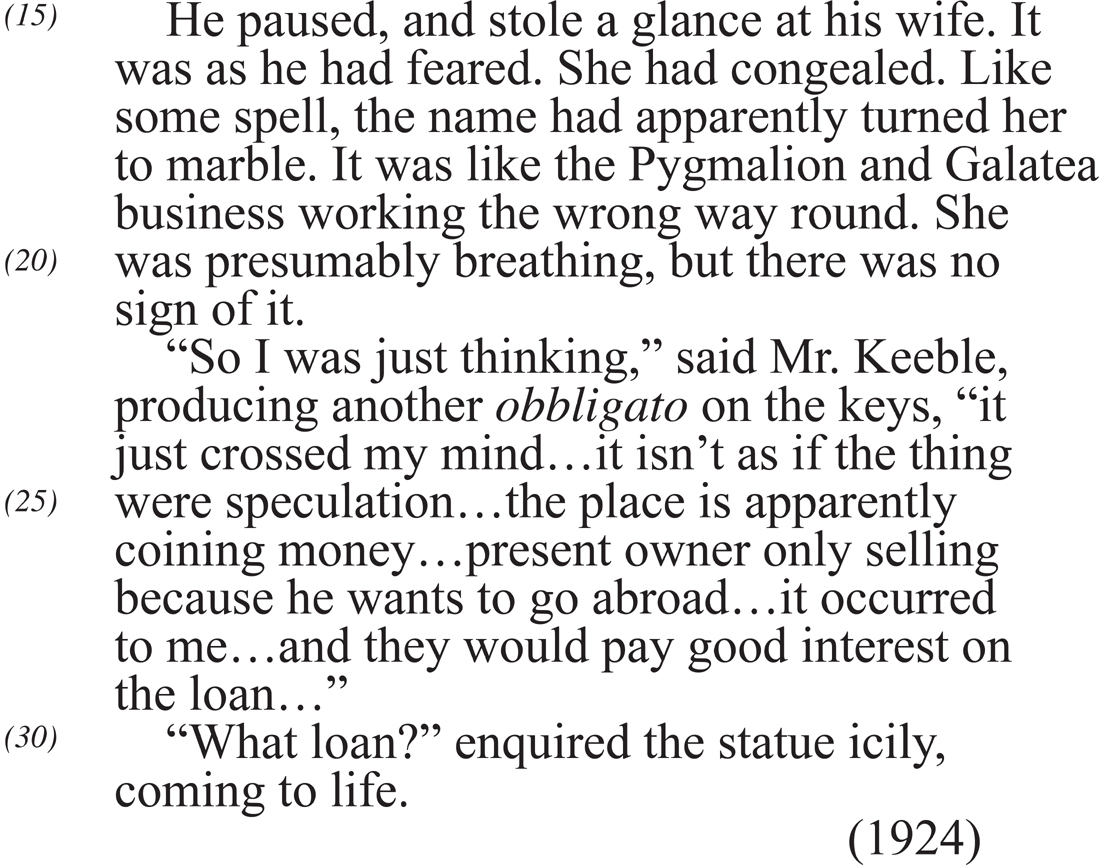
19. Which of the following is the intended effect of the pauses in Mr. Keeble’s conversation?
(A) It demonstrates that he is a feeble man.
(B) It makes his speech disjointed.
(C) It shows his hesitancy in approaching his wife.
(D) It slows the rhythm of the conversation.
(E) It elucidates his main point.
20. Which of the following expresses a mythological allusion made in the passage?
(A) “interest on the loan” (lines 28-29)
(B) “no sign of it” (lines 20-21)
(C) “turned her to marble” (lines 17-18)
(D) “in Lincolnshire” (line 12)
(E) “the Pygmalion and Galatea business” (lines 18-19)
21. All of the following represent metaphors or similes used by the author EXCEPT
(A) “She had congealed” (line 16)
(B) “enquired the statue icily” (line 30)
(C) “coming to life” (line 31)
(D) “presumably breathing” (line 20)
(E) “Like some spell” (lines 16-17)
22. The phrase “the place is apparently coining money” (lines 25-26) is meant to imply
(A) the farm is presently engaged in illegal activities
(B) the farm is profitable
(C) the investment is unnecessary
(D) the farm serves as a bank for the local people
(E) Lincolnshire is a profitable place to live
23. Which of the following expresses Mr. Keeble’s wife’s feeling toward the loan?
(A) Amused detachment
(B) Utter disgust
(C) Preformed opposition
(D) Blatant apathy
(E) Neutrality
24. All of the following are physical manifestations of Mr. Keeble’s anticipation of his wife’s response EXCEPT
(A) “Keenly alive” (line 1)
(B) “had to rattle the keys” (line 3)
(C) “was not looking at his wife” (line 5)
(D) “his eyes on the carpet” (line 10)
(E) “producing another obbligato” (line 23)
25. The phrase “in Lincolnshire, I think she said” (lines 12-13) implies that which of the following is true of Keeble?
(A) Keeble is unaware of the location of the farm.
(B) Keeble thinks the location is unimportant.
(C) Keeble’s memory is failing.
(D) Keeble is attempting to appear casual.
(E) Keeble wants to conceal the location from his wife.
26. Keeble’s relationship with his wife is such that
I. He seeks her affection
II. He is disgusted by her
III. He is intimidated by her
(A) II only
(B) III only
(C) I and III only
(D) II and III only
(E) I, II, and III
27. The last line implies which of the following?
(A) Mr. Keeble’s wife is not interested in lending money.
(B) Mr. Keeble’s wife is tempted by the proposition.
(C) Mr. Keeble has succeeded in his mission.
(D) Mr. Keeble’s wife is keeping an open mind about the loan.
(E) Mr. Keeble’s wife wants to hear more about the loan.
Questions 28-37. Read the following passage carefully before you choose your answers.
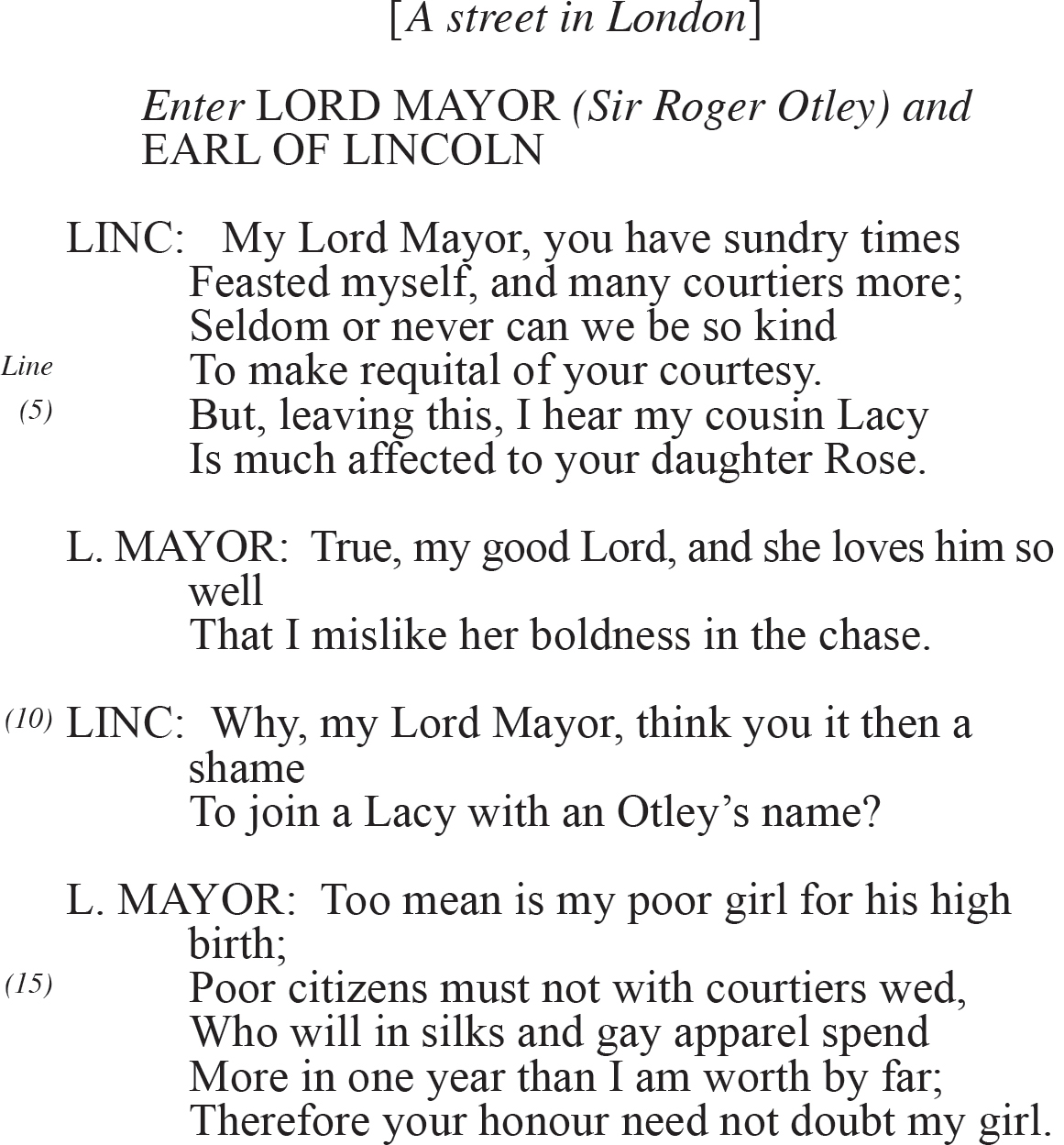
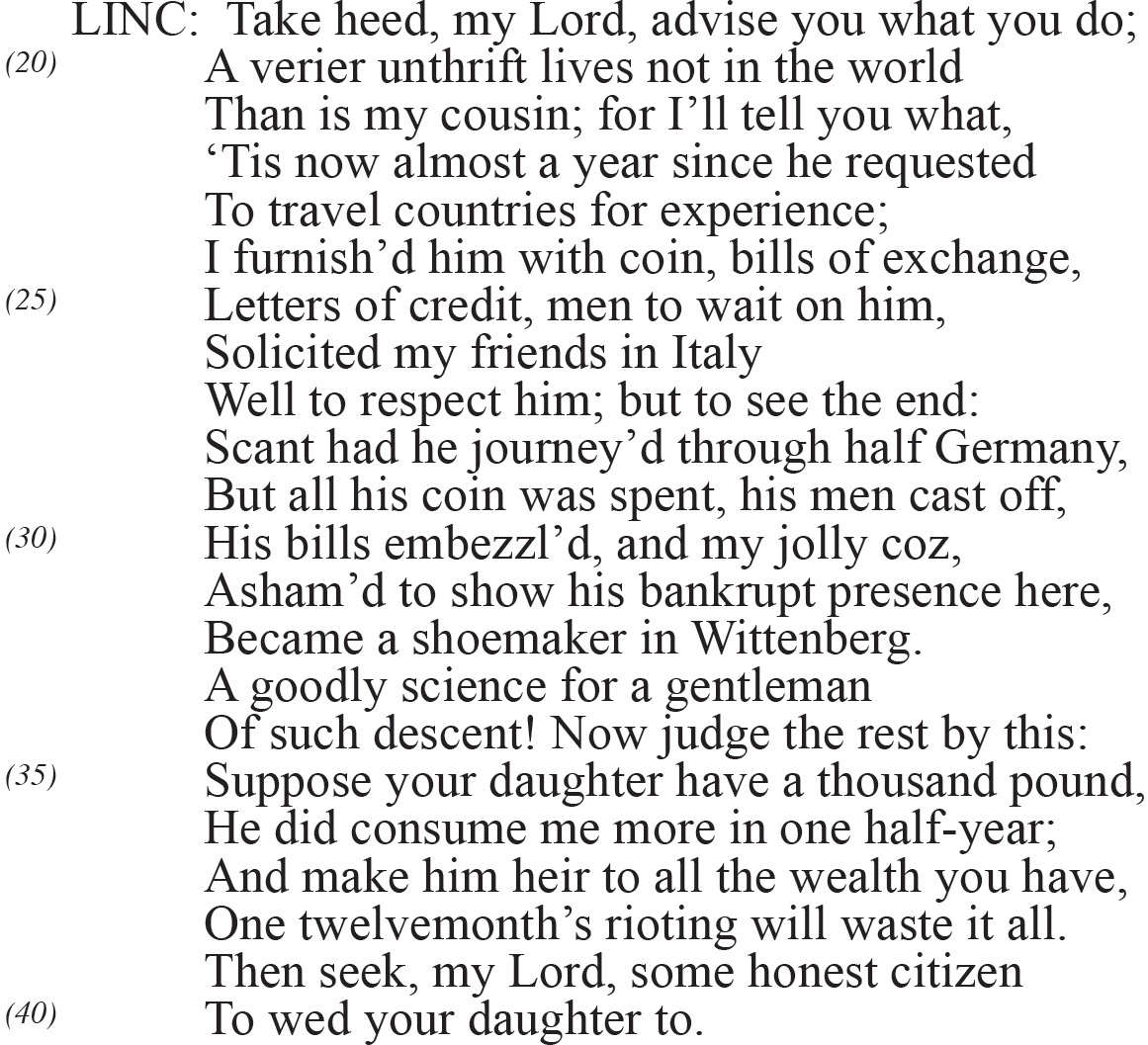
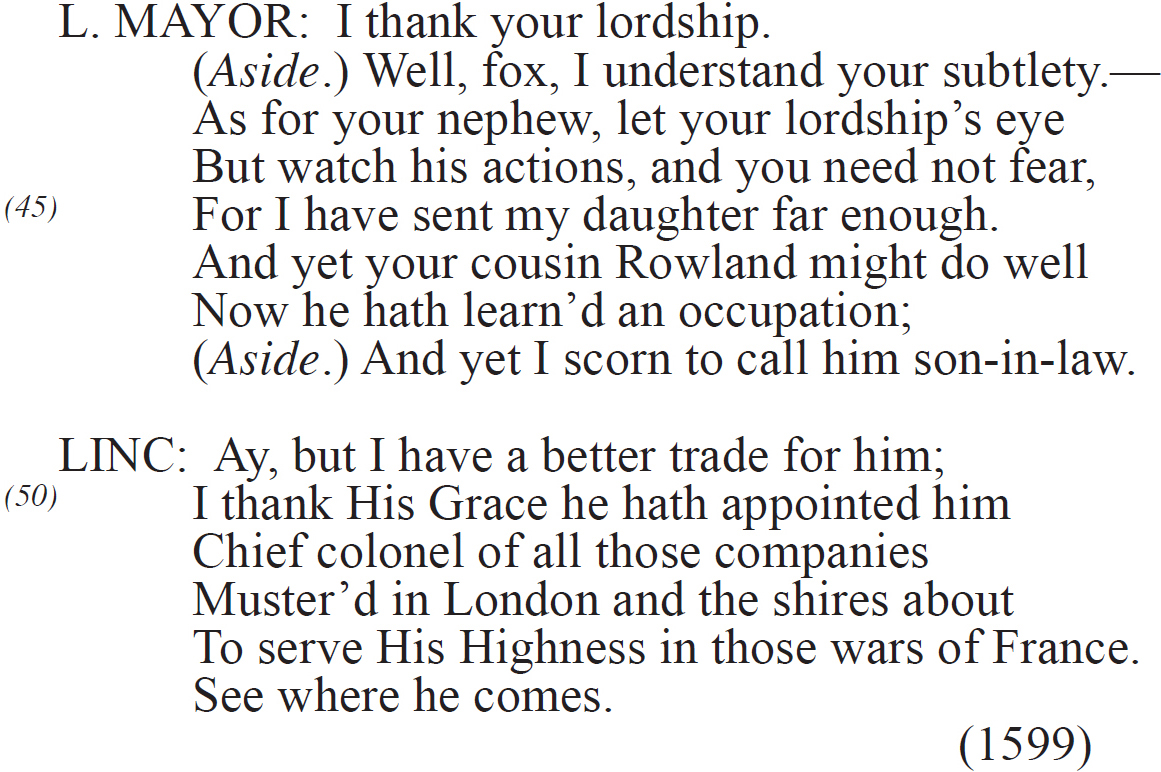
28. The word “sundry” (line 1) most nearly means
(A) groceries
(B) numerous
(C) provisions
(D) infrequent
(E) few
29. It can be inferred from the passage that the primary reason the Lord Mayor sent his daughter “far enough” is that he
(A) believes she is chasing after a man who is not interested in marrying her
(B) regrets the state of poverty in which his family lives
(C) does not wish to have his daughter marry Lacy
(D) fears what the Earl of Lincoln might do
(E) looks down on the trade of shoemaking
30. What reason does the Earl of Lincoln give for his opposition to Lacy and Rose’s marriage?
(A) Rose is not a pleasant person.
(B) Courtiers cannot marry.
(C) The wedding will be too expensive.
(D) Lacy does not love Rose.
(E) Lacy will not be able to provide for Rose.
31. The Earl of Lincoln’s attitude toward his cousin can best be described as
(A) censoriousness
(B) apathy
(C) romantic love
(D) dislike
(E) affection
32. It can be inferred from the sentence “A goodly science for a gentleman/Of such descent!” (lines 33-34) that
(A) the profession of shoemaker is not appropriate for someone of high birth
(B) shoemakers often declare bankruptcy
(C) the Earl of Lincoln admires the profession of shoemaker
(D) as a shoemaker, the Earl of Lincoln’s cousin will make a thousand pounds a year
(E) shoemaking is a scientific occupation
33. The Lord Mayor’s attitude toward Lacy can best be described as
(A) reluctant affection
(B) avuncular indulgence
(C) cautious approval
(D) undeserved respect
(E) disguised disapproval
34. The line “Well, fox, I understand your subtlety” (line 42)
(A) allows the Lord Mayor to speak to the Earl of Lincoln without others hearing them
(B) provides privileged insight into the Lord Mayor’s attitude
(C) alienates the audience by prevarication
(D) creates an atmosphere of unease in the play
(E) insults the Earl of Lincoln
35. All of the following words are used to describe Lacy EXCEPT
(A) “affected” (line 6)
(B) “high” (line 13)
(C) “poor” (line 13)
(D) “unthrift” (line 20)
(E) “jolly” (line 30)
36. This scene reveals a conflict between
(A) generosity and frugality
(B) prodigality and profligacy
(C) youth and age
(D) joy and melancholy
(E) expression and emotions
37. The author has the Earl of Lincoln mention the French wars (line 53) in order to
(A) reveal Lacy’s new profession
(B) foreshadow a military death
(C) elucidate the causes of the conflict
(D) explain a system of privilege
(E) home in on a national debate
Questions 38-45. Read the following poem carefully before you choose your answers.
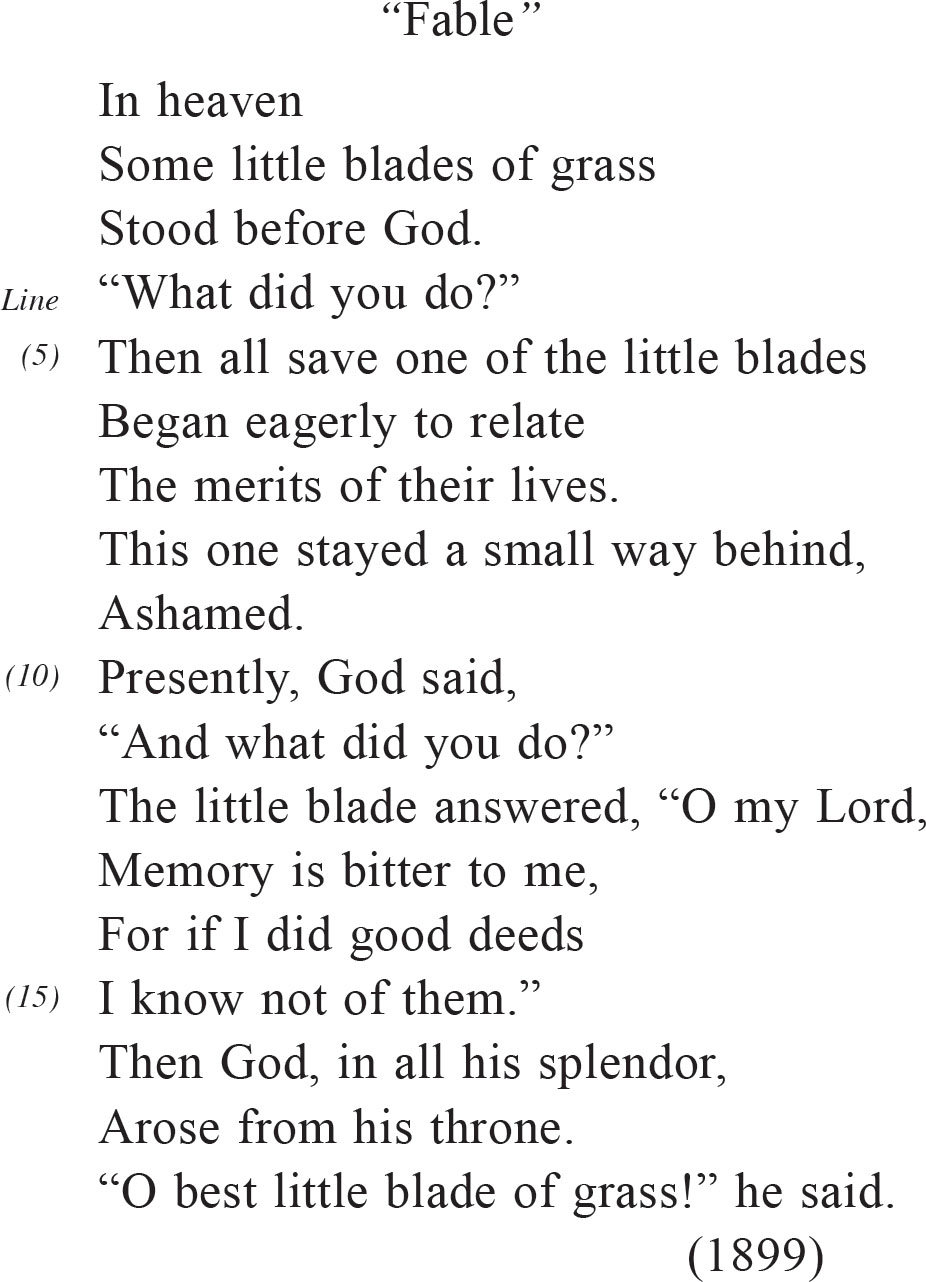
38. It can be inferred that the speaker(s) in line 4 is/are
(A) an angel
(B) St. Peter
(C) the blades of grass
(D) God
(E) the one little blade of grass
39. God’s attitude toward the last little blade of grass may best be described as
(A) condescending
(B) neutral
(C) admiring
(D) disdainful
(E) morally superior
40. The main idea of the poem is that
(A) it is better to do nothing than too much
(B) it is better to forget if you have done something wrong
(C) it is better to be modest than to be boastful
(D) it is better to keep your problems to yourself
(E) if you need to tell your bad deeds to someone, you are not worthy of respect
41. The word “presently” (line 10) means which of the following in the context of the poem?
I. As a gift
II. After a while
III. Changing the topic
(A) I only
(B) II only
(C) I and III only
(D) II and III only
(E) I, II, and III
42. It can be inferred that the small blade was “ashamed” (line 9) because
(A) it was smaller than the others
(B) it was disgusted with the other blades of grass
(C) it didn’t feel worthy of God’s attention
(D) it was bitter and lonely
(E) it thought its acts greater than the others’ acts
43. The fact that God called the one blade “‘O best’” (line 18) can best be characterized as
(A) unexpected
(B) satiric
(C) tragic
(D) comic
(E) unfortunate
44. Which is the effect of lines 16-17 in relation to the rest of the poem?
(A) They reveal God’s egotism.
(B) They heighten anticipation for the last line.
(C) They shift the narrative voice.
(D) They echo the last lines of the first stanza.
(E) They reveal the poet’s true feelings.
45. God’s attitude toward the blades of grass as a group is
(A) shameful
(B) unstated
(C) disgusted
(D) disapproving
(E) melancholy
Questions 46-54. Read the following passage carefully before you choose your answers.

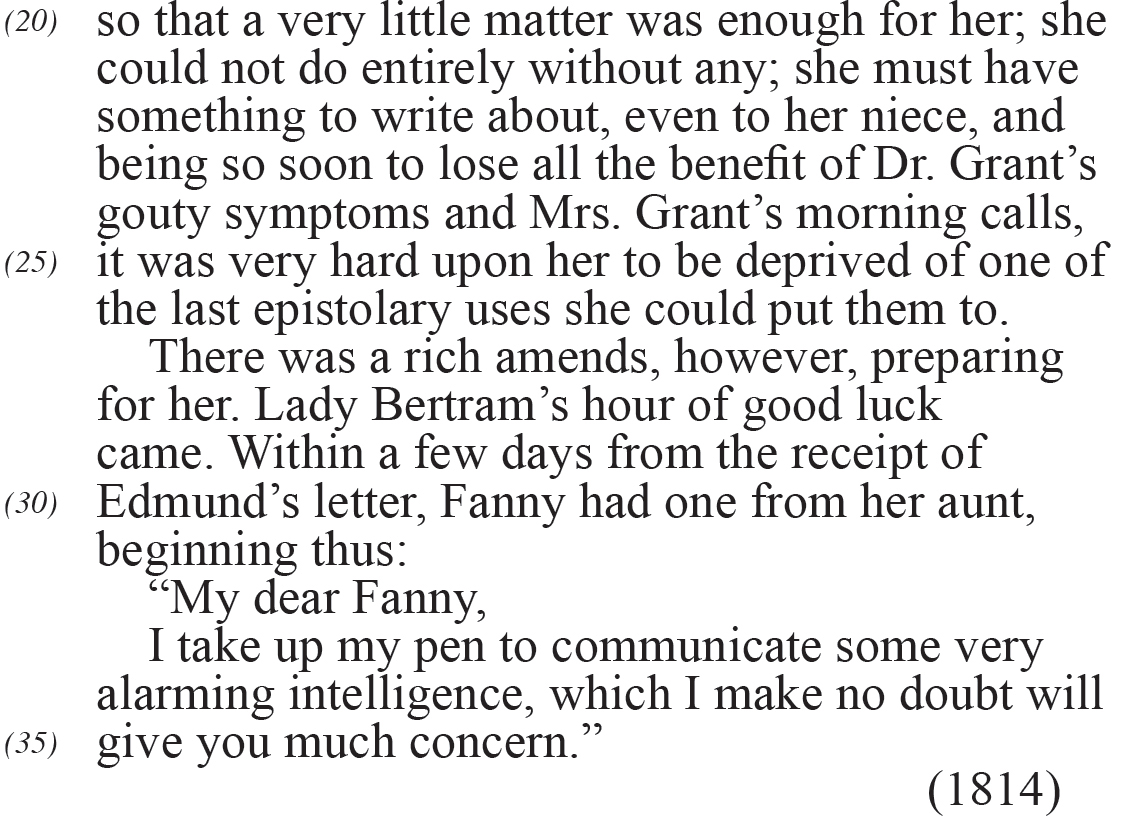
46. The narrative tone in the above piece can best be described as
(A) wry
(B) bitterly ironic
(C) detached
(D) melodramatic
(E) secretive
47. What is implied by the phrase “could make no advantage of it” (lines 7-8)?
(A) Lady Bertram could use the news to suit her best interest.
(B) Lady Bertram was unable to write about the news.
(C) Lady Bertram could not relay the news in a pleasant light.
(D) Lady Bertram could convey only part of the news.
(E) Lady Bertram was bound to secrecy.
48. In context, the word “want” (line 15) means
(A) requirement
(B) desire
(C) poverty
(D) lack
(E) defect
49. What is the “benefit” referred to in line 23?
(A) Friends with whom to visit
(B) The ability to assist others
(C) A house full of visitors
(D) People willing to write letters
(E) News to write about
50. The “amplifying style” (line 19) is one in which
(A) things sound more important than they are
(B) small bits of news are stretched in importance
(C) the speaker’s voice is very loud
(D) people are made to sound grand
(E) one writes in a large, bold print
51. It can be inferred that Sir Thomas is
(A) Lady Bertram’s son
(B) Lady Bertram’s husband
(C) a boarder at Mansfield
(D) a relative of the Grants
(E) a friend of Lady Bertram
52. The last three lines serve to illustrate which of the following about Lady Bertram?
(A) She has found something to write about.
(B) She is spreading malicious rumors.
(C) She is concerned about the news she is sending.
(D) She is unaware of Fanny’s feelings.
(E) She is worried about her niece.
53. Lady Bertram is best described as
(A) a social pariah
(B) an unwanted family member
(C) a disenfranchised member of society
(D) a gossipy member of the gentry
(E) a disillusioned elderly woman
54. The phrase “even to her niece” (line 22) shows that Lady Bertram
(A) doesn’t much care for her niece
(B) is unhappy with her niece
(C) is uncomfortable around her niece
(D) doesn’t need to have much to say to her niece
(E) dislikes the prospect of writing to her niece
Questions 55-61. Read the following poem carefully before you choose your answers.
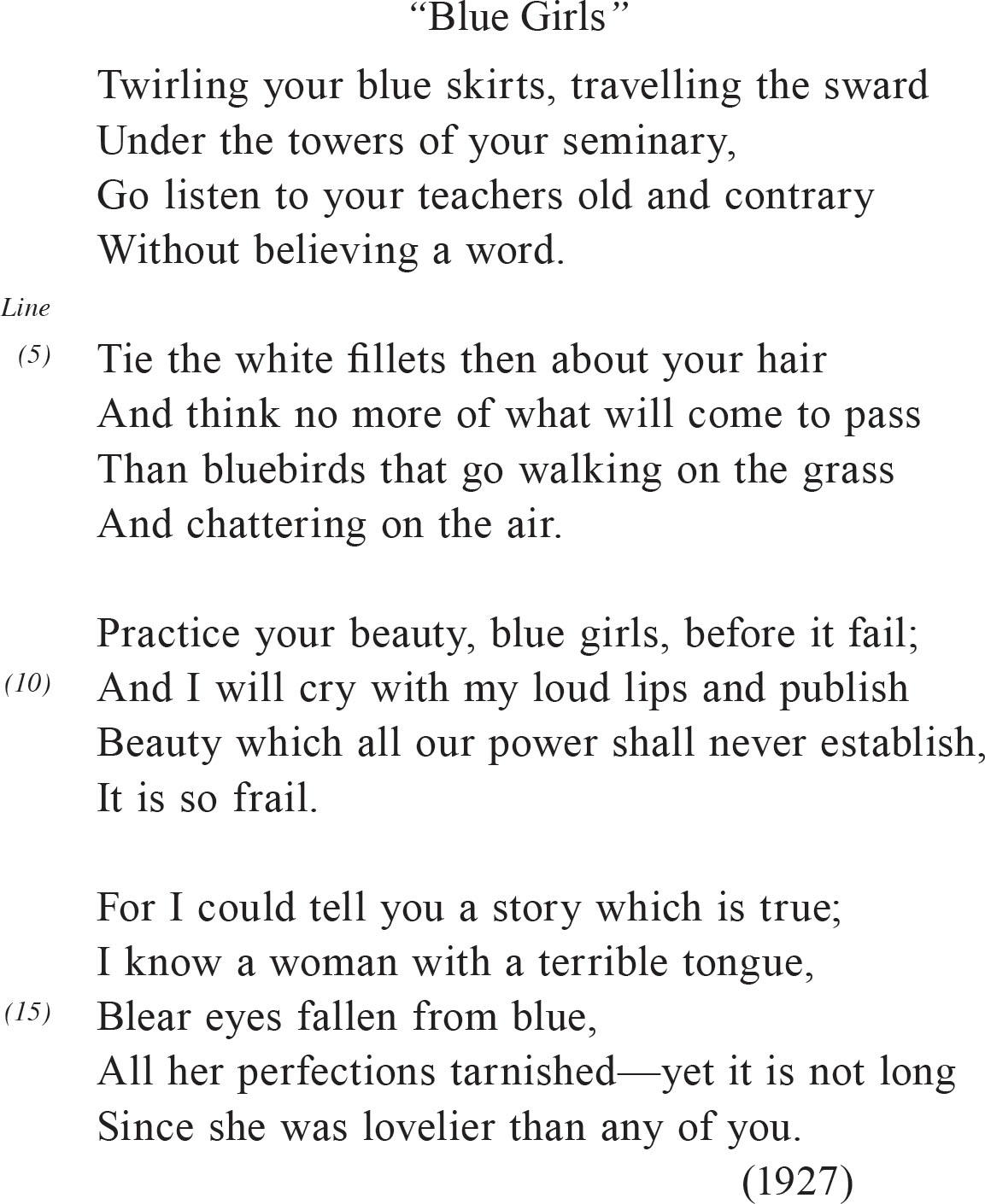
55. The tone of the poem can best be described as
(A) cautionary
(B) mythic
(C) sarcastic
(D) optimistic
(E) hopeful
56. The poem is primarily concerned with
(A) the importance of beauty
(B) the lesson to be learned from the past
(C) the fleeting nature of youth
(D) telling a story for the girls’ benefit
(E) the permanence of death
57. “Blear eyes fallen from blue” (line 15) is most probably meant to suggest that
(A) the woman’s beauty has deteriorated
(B) the woman is tired
(C) the woman is going blind
(D) disease can happen suddenly
(E) the girls are responsible for the woman’s loss of beauty
58. “And chattering on the air” (line 8) refers to
I. the girls
II. the bluebirds
III. the teachers
(A) I only
(B) I and II only
(C) I and III only
(D) II and III only
(E) I, II, and III
59. It can be inferred that the girls to whom the poem is addressed are most likely to see the speaker as being like
(A) their “teachers old and contrary” (line 3)
(B) people who chatter like bluebirds
(C) the woman mentioned in the final stanza
(D) older women who are jealous of their beauty
(E) a poet who fails to get his work published
60. The phrases “Without believing a word” (line 4) and “think no more” (line 6) illustrate the girls’
(A) innate sense of suspicion
(B) inherent difficulty with understanding subjects
(C) lack of concern about weighty subjects
(D) frail nature
(E) disregard for the feelings of others
61. The poem’s theme could best be described as
(A) she who hesitates is lost
(B) beauty is a fading flower
(C) all that glitters is not gold
(D) beauty is truth, truth beauty
(E) a penny saved is a penny earned
STOP
IF YOU FINISH BEFORE TIME IS CALLED, YOU MAY CHECK YOUR WORK ON THIS SECTION ONLY. DO NOT TURN TO ANY OTHER SECTION IN THE TEST.